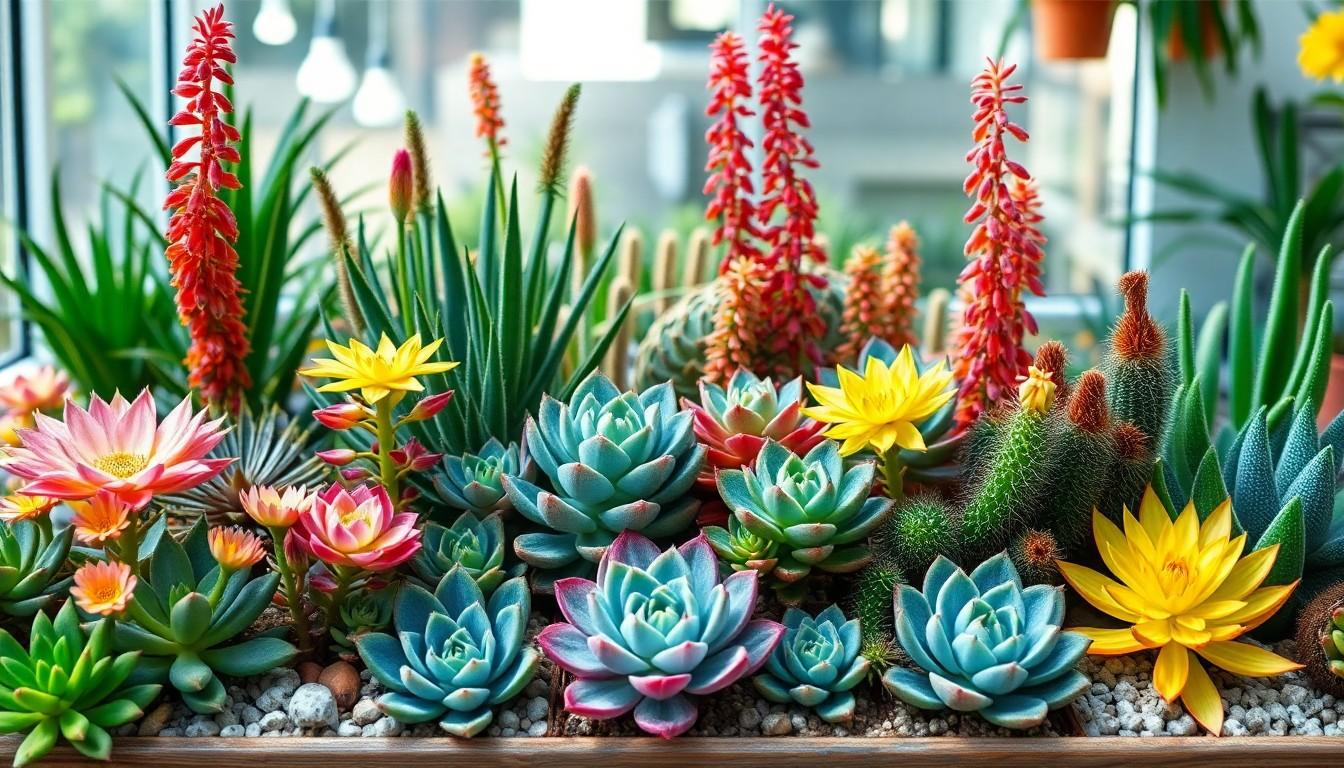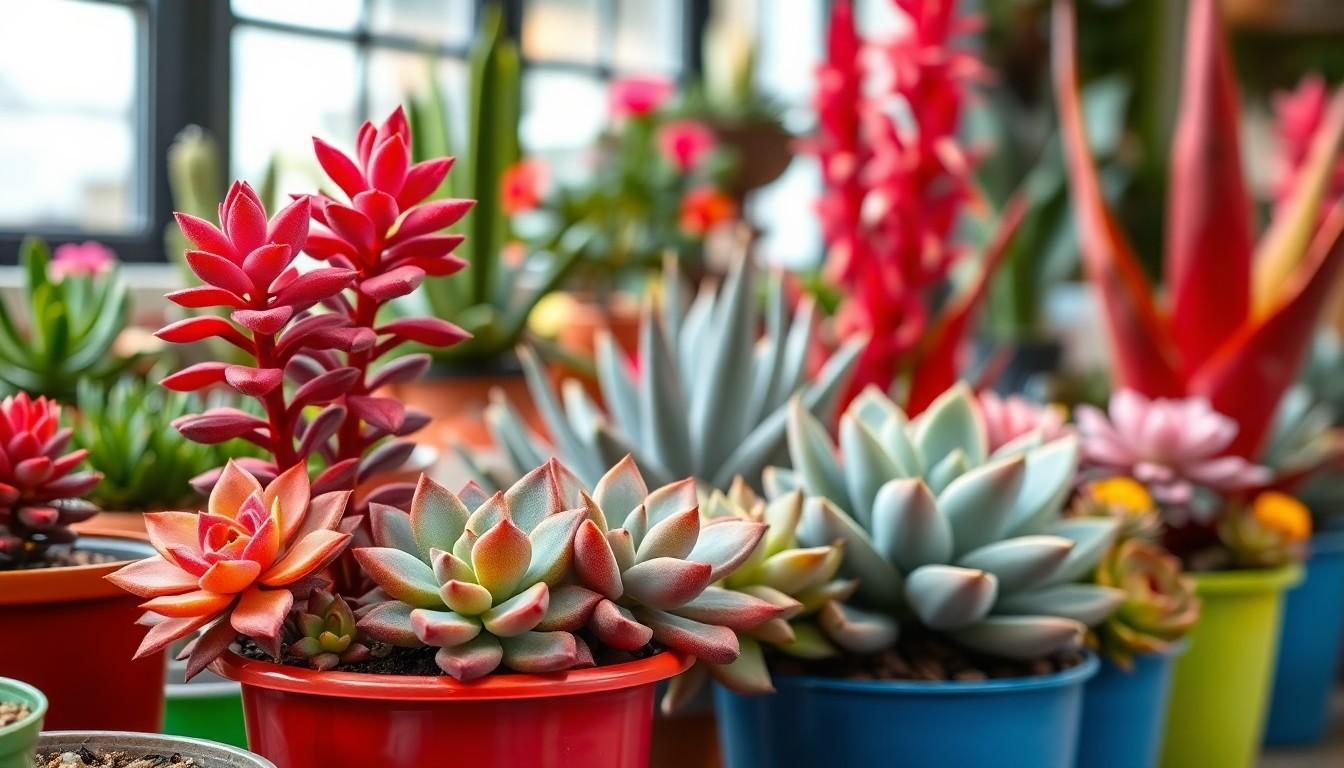When you think of succulents, you might picture those adorable little green blobs that seem to thrive on neglect. But wait—there’s more! Some of these resilient plants have a secret talent: they can bloom into stunning flowers. Yes, you read that right. These botanical wonders not only survive drought but also throw a floral fiesta that’ll make your neighbors green with envy.
Imagine a world where your low-maintenance plants surprise you with vibrant blossoms, turning your home into a mini desert paradise. From the quirky Echeveria to the elegant Aloe, succulents that flower bring a splash of color and personality to any space. So, buckle up and get ready to discover the most delightful succulents that’ll not only make your friends say, “Wow!” but also give your indoor garden a whole new dimension.
Overview of Succulents That Flower
Succulents that flower create stunning displays, adding bursts of color to various environments. Many succulent species bloom under the right conditions, often surprising enthusiasts with vibrant blossoms. Notably, Echeveria produces striking rosettes that bear delicate flowers in shades of pink, orange, and yellow. Some Aloe varieties, like Aloe vera, not only serve practical uses but also display tall flower spikes adorned with tubular, fiery red blooms.
Succulents thrive in diverse settings, making them adaptable choices for indoor or outdoor gardens. While some flowering succulents bloom seasonally, others display flowers year-round. Flowering often depends on light, temperature, and water availability, showcasing the resilience of these plants. It’s essential to understand each succulent’s needs for optimal blooming; adequate sunlight typically promotes more robust flowering.
Care routines also affect flowering. Regularly providing well-draining soil and avoiding overwatering encourages healthy growth. Attention to the specific light requirements of each succulent enhances bloom production. For instance, Jade plants respond positively to bright light, resulting in clusters of star-like flowers.
Each succulent species offers unique beauty through its blossoms. By selecting a variety of flowering succulents, individuals can create a visually dynamic garden. Embracing the allure of flowering succulents leads to enriching home environments filled with vibrant creativity and natural charm.
Types of Flowering Succulents

Flowering succulents encompass a variety of species, each contributing unique colors and forms to indoor and outdoor spaces. Exploring popular varieties and unique species reveals the diversity and allure of these plants.
Popular Varieties
Echeveria stands out for its stunning rosettes that produce delicate flowers in hues of pink, orange, and yellow. Aloe, particularly Aloe vera, showcases tall spikes adorned with vivid red blooms. Sedum varieties, like Sedum morganianum, offer cascading flowers that attract pollinators. Other common types include the vibrant Crassula ovata and the striking Haworthia, both known for their eye-catching floral displays. These familiar succulents thrive in various environments, enhancing indoor gardens and outdoor landscapes alike.
Unique Species
Lithops, known as living stones, present an unusual flowering style with blooms appearing above their stone-like formations. Some species of Stapelia exhibit star-shaped flowers adorned with intriguing patterns, emitting distinct scents to attract pollinators. The unique flowers of Euphorbia, resembling traditional blooms yet distinctively vibrant, add character to gardens. Additionally, the quirky Huernia produces exotic-looking flowers that challenge the conventional aesthetic of flowering plants. These unique species enhance collections, showcasing that succulents can be surprising and visually captivating.
Growing Conditions for Flowering Succulents
To thrive, flowering succulents require specific growing conditions. These conditions influence their ability to bloom vibrantly.
Light Requirements
Bright, indirect sunlight promotes healthy growth in flowering succulents. Placing these plants near a south or west-facing window often yields the best results. Too much direct sun may scorch their leaves, while insufficient light can hinder blooming. Adjusting exposure based on seasonal changes helps maintain optimal light conditions. In the absence of sufficient natural light, using grow lights can effectively supplement their needs.
Soil and Watering Needs
Well-draining soil proves essential for flowering succulents. A mix containing elements like cactus soil, sand, and perlite ensures proper drainage. Watering should occur only when the top inch of soil feels dry. Overwatering presents a risk, as it may lead to root rot, stifling growth and blooming. During the growing season, applying a diluted liquid fertilizer every four to six weeks can support blooming potential. Adequate moisture and nutrient balance foster the health and vibrancy of succulent flowers.
Care Tips for Thriving Flowers
Providing proper care ensures flowering succulents reach their full potential. Attention to specific techniques can enhance their growth and blooming.
Fertilization Techniques
Regular fertilization boosts flowering capabilities. During the growing season, use a diluted liquid fertilizer every four to six weeks. Opt for a balanced, water-soluble fertilizer designed for succulents. Concentrate on applying it to moist soil to avoid root burn. Reducing fertilizer frequency during the dormant winter months allows plants to rest. Adjusting nutrient levels based on specific succulent varieties can also yield better results. Nearly all flowering succulents benefit from occasional feeding.
Pruning and Maintenance
Pruning promotes healthy growth and vibrant blooms. Remove dead or dried leaves to enhance airflow and prevent disease. Using clean, sharp scissors helps avoid injury to the plant. Regularly inspect for spent flowers and cut them off at the base to encourage new growth. Tidying the plant not only enhances appearance but also focuses energy on blooming. Establishing a maintenance schedule every few weeks can create a thriving environment. Observing these simple steps keeps flowering succulents healthy and full of life.
Conclusion
Flowering succulents offer a unique way to bring life and color into any space. Their vibrant blooms not only enhance the aesthetic appeal of indoor and outdoor gardens but also reflect the adaptability and resilience of these remarkable plants.
By selecting the right varieties and providing optimal care, anyone can cultivate a flourishing succulent garden. The right conditions can lead to stunning floral displays that captivate and inspire. With a little attention to light, soil, and watering practices, flowering succulents can thrive and transform any environment into a lively oasis. Embracing these beautiful plants is a rewarding journey for both novice and seasoned gardeners alike.

